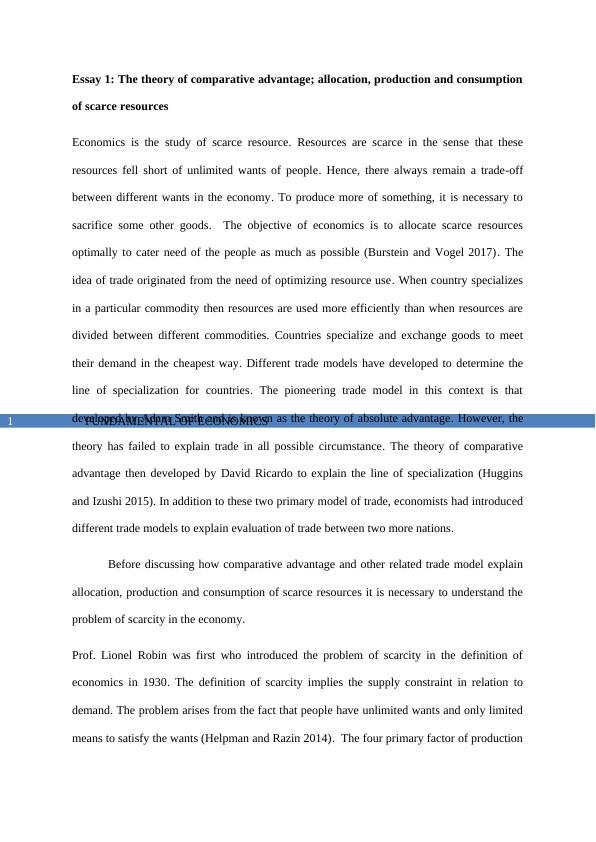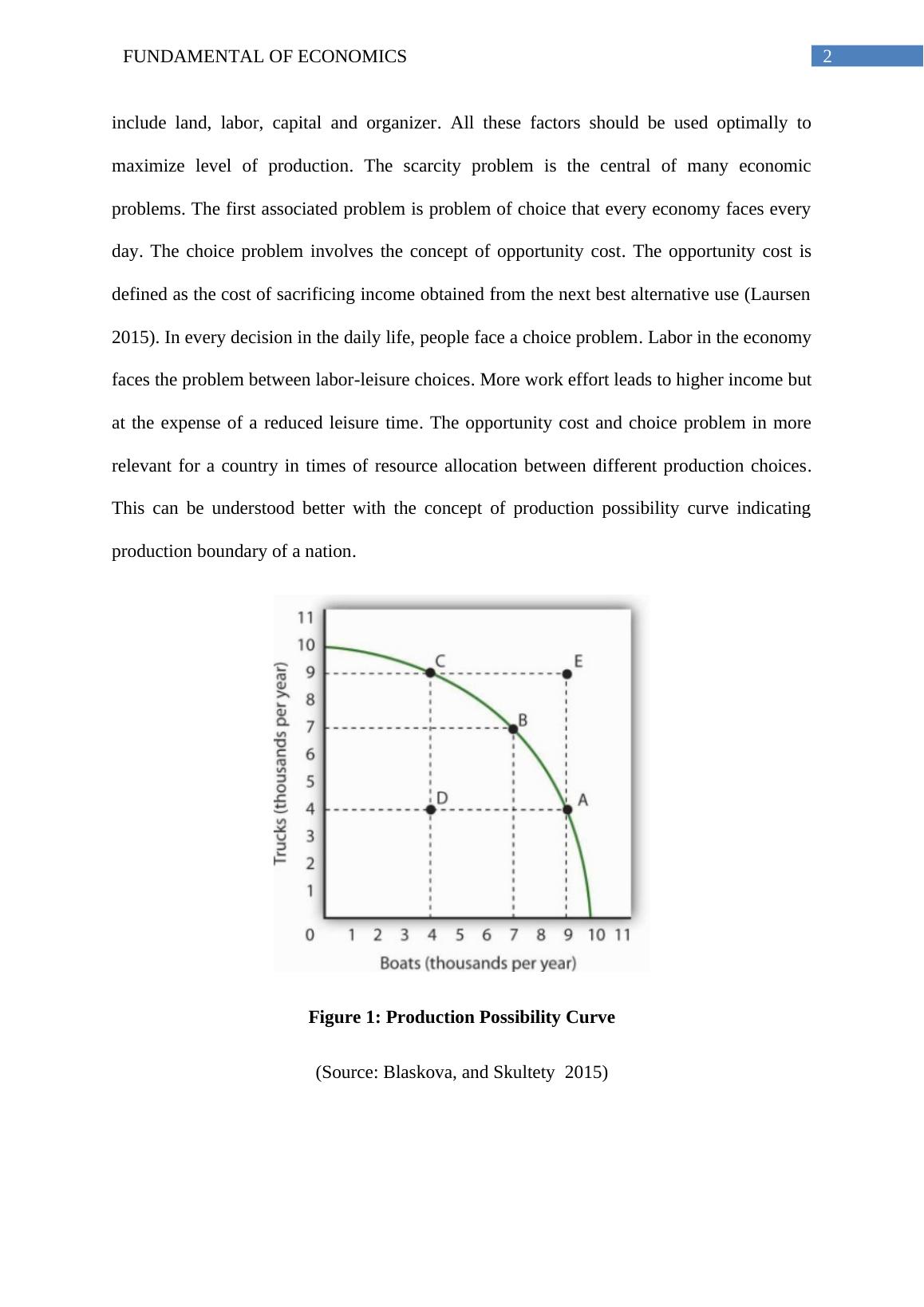Assignment on Fundamentals of Economics (pdf)
Added on 2021-04-19
12 Pages2833 Words374 Views
Running Head: FUNDAMENTAL OF ECONOMICS Fundamental of EconomicsName of the StudentName of the UniversityAuthor note

FUNDAMENTAL OF ECONOMICS 1Essay 1: The theory of comparative advantage; allocation, production and consumptionof scarce resources Economics is the study of scarce resource. Resources are scarce in the sense that theseresources fell short of unlimited wants of people. Hence, there always remain a trade-offbetween different wants in the economy. To produce more of something, it is necessary tosacrifice some other goods. The objective of economics is to allocate scarce resourcesoptimally to cater need of the people as much as possible (Burstein and Vogel 2017). Theidea of trade originated from the need of optimizing resource use. When country specializesin a particular commodity then resources are used more efficiently than when resources aredivided between different commodities. Countries specialize and exchange goods to meettheir demand in the cheapest way. Different trade models have developed to determine theline of specialization for countries. The pioneering trade model in this context is thatdeveloped by Adam Smith and is known as the theory of absolute advantage. However, thetheory has failed to explain trade in all possible circumstance. The theory of comparativeadvantage then developed by David Ricardo to explain the line of specialization (Hugginsand Izushi 2015). In addition to these two primary model of trade, economists had introduceddifferent trade models to explain evaluation of trade between two more nations. Before discussing how comparative advantage and other related trade model explainallocation, production and consumption of scarce resources it is necessary to understand theproblem of scarcity in the economy. Prof. Lionel Robin was first who introduced the problem of scarcity in the definition ofeconomics in 1930. The definition of scarcity implies the supply constraint in relation todemand. The problem arises from the fact that people have unlimited wants and only limitedmeans to satisfy the wants (Helpman and Razin 2014). The four primary factor of production

FUNDAMENTAL OF ECONOMICS 2include land, labor, capital and organizer. All these factors should be used optimally tomaximize level of production. The scarcity problem is the central of many economicproblems. The first associated problem is problem of choice that every economy faces everyday. The choice problem involves the concept of opportunity cost. The opportunity cost isdefined as the cost of sacrificing income obtained from the next best alternative use (Laursen2015). In every decision in the daily life, people face a choice problem. Labor in the economyfaces the problem between labor-leisure choices. More work effort leads to higher income butat the expense of a reduced leisure time. The opportunity cost and choice problem in morerelevant for a country in times of resource allocation between different production choices.This can be understood better with the concept of production possibility curve indicatingproduction boundary of a nation. Figure 1: Production Possibility Curve (Source: Blaskova, and Skultety 2015)

FUNDAMENTAL OF ECONOMICS 3The production possibility curve is built in a two goods framework that assumes usingall the resources; the nation can produce two goods. As shown from the figure above,increasing production of any one good involve a decreasing production of the other good. From the resource allocation and choice problem leads to three central question of theeconomy- what to produce, how to produce and for whom to produce. Trade relation bydefining specialization and exchange helps to answers these questions with respectiveconsequences on the economy and society (Burstein and Vogel 2017). Absolute advantage and evaluation of comparative advantage:Absolute advantage refers tothe ability of a nation to produce a good at a relatively lower unit cost production comparedto other nation. Having absolute advantage in a good implies country can produce the specificgood with a fewer resources and hence, incur a lower cost (Levchenko and Zhang 2016). Ahypothetical example is given be to understand the theory of absolute advantage. The tablebelow shows the output per worker in a year for the two US and Brazil. CarsBicyclesUS51Brazil28As shown from the table, US can produce 5 cars and 1 bi-cycle in a year by using onelabor. Brazil in contrast produces 2cars and 8 bicycles with the same input. Therefore, US hasan absolute advantage in cars while Brazil has an absolute advantage in Bicycles. In reality, however countries often enjoy absolute advantage in both goods because ofabundant stock of resources and efficient technology. Under such circumstance, the way outis given by the comparative advantage theory (Caselli et al. 2015). The theory states thatwhen one nation has an absolute cost advantage in both goods then specialization should bedefined based on the opportunity cost or production. Because of resource constraint,

End of preview
Want to access all the pages? Upload your documents or become a member.
Related Documents
Fundamentals of Economics PDFlg...
|11
|2464
|33
Fundamentals of economics assignmentlg...
|12
|2348
|33
The Scarcity Principle and Its Implicationslg...
|5
|753
|458
Microeconomics: Concepts of Want, Scarcity, Factors of Production and Choiceslg...
|6
|856
|317
ECO10250 - Economics For Decision Making SCUlg...
|13
|2040
|45
Theory of comparative advantage and allocation of scarce resourceslg...
|11
|2741
|217
